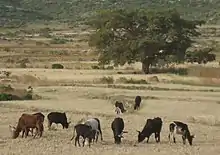Arado cattle
The red and black coated Arado cattle are small and hardy. They are the most common cattle variety in the north Ethiopian highlands. The Arado breed is part of the Zenga breed group. It is essentially reared for draught power, particularly tillage. The breed feeds mainly on crop residues; it is adapted to seasonal feed shortages. This breed is often cross-bred through bull and artificial insemination services.[1][2]
 Arado cattle in aftermath grazing in Dogu'a Tembien | |
| Country of origin | Ethiopia |
|---|---|
| Distribution | north Ethiopian highlands |
| Use | Draught, meat, milk (in that order) |
| Traits | |
| Weight |
|
| Coat | red, black, stained |
| Horn status | medium |
| |
Physical characteristics
The Arado cattle have red and black coats. Bulls and oxen have thick and short horns and a cervicothoracic hump; cows have medium, thin horns. Oxen weigh 254 kg and cows 201 kg on average. The average height at withers of 120 and 115 cm.[1]
Closely related types
Origin of the cattle breed
Ethiopia has been at a crossroads for cattle immigration to Africa[3][4] due to
- proximity to the geographical entry of Indian and Arabian zebu
- proximity to Near-Eastern and European taurine
- introgression with West African taurine due to pastoralism
Furthermore, the diverse agro-ecology led to diverse farming systems which, in turn, made Ethiopia a centre of secondary diversification[3] for livestock :
- The Sanga cattle originated in Ethiopia. They are a major bovine group in Africa – a cross-breeding of local long-horned taurines and Arabian zebus[4]
- The Arado cattle are part of the Zenga (Zebu-Sanga) breeds, which resulted from a second introduction and crossing with Indian zebu[4]
Breeding and genetic resource management
Mating takes place on the grazing grounds, or the cow is brought to a bull in the neighbourhood.[1][3] Farmers try essentially to improve the Arado breed through crossbreeding with other indigenous breeds. This favours selection for fitness, and the adaptation to broader farming system and environmental conditions.[1][3]
Stresses on the cattle breed
- socio-political: urbanisation, and civil wars
- panzootic: cattle plague[5]
- environmental: destruction of ecosystems and droughts[6]
References
- Cattle breeds, milk production, and transhumance in Dogu'a Tembien. In: Geotrekking in Ethiopia's tropical mountains, Chapter 28. Cham: SpringerNature. 2019. doi:10.1007/978-3-030-04955-3_28. S2CID 199323600.
- Merha Zerabruk; Vangen, O; Mitiku Haile (2007). "The status of cattle genetic resources in North Ethiopia: On-farm characterization of six major cattle breeds". Animal Genetic Resources Information. 40: 15–32. doi:10.1017/S1014233900002169.
- Merha Zerabruk, and colleagues (2011). "Genetic diversity and admixture of indigenous cattle from North Ethiopia: implications of historical introgressions in the gateway region to Africa". Animal Genetics. 43 (3): 257–266. doi:10.1111/j.1365-2052.2011.02245.x. PMID 22486496.
- Hanotte, O. and colleagues (2002). "African pastoralism: genetic imprints of origins and migrations". Science. 296 (5566): 336–339. Bibcode:2002Sci...296..336H. doi:10.1126/science.1069878. PMID 11951043. S2CID 30291909.
- Pankhurst, R (1985). The history of famine and epidemics in Ethiopia prior to the twentieth century. Addis Ababa: Relief and Rehabilitation Commission.
- Van Cappellen, H (2016). The ox-plow complex on the edge: an ethnographic inquiry into social change and cross-breed dairy farming in Tigray, Ethiopia [MSc Thesis]. KU Leuven, Belgium.